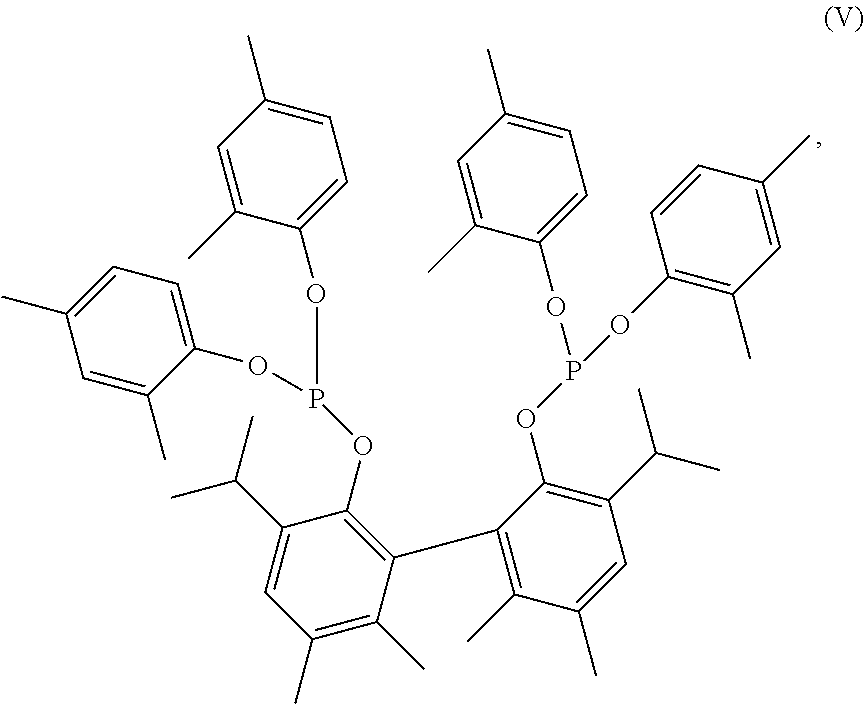Composition for improved nickel-ligand solubility
a technology of nickelligand and solubility, which is applied in the direction of catalyst activation/preparation, organic compound/hydride/coordination complex catalyst, physical/chemical process catalyst, etc., can solve the problem of not being very economical in the process, and achieve the effect of greater metal solubility
- Summary
- Abstract
- Description
- Claims
- Application Information
AI Technical Summary
Benefits of technology
Problems solved by technology
Method used
Image
Examples
example 12
reparation: (XIII) Ligand Solution with 3-Pentenenitrile
[0124]In a nitrogen glove-box, nickel metal, 0.40 g, (XIII) ligand solution, 1.05 g and 97% 3-pentenenitrile, 3.91 g were combined in a 10 ml serum bottle sealed with a Teflon lined septum. The solution was stirred with a magnetic stirrer at 65° C. for 24 hours to obtain a nickel catalyst solution. The amount of nickel in solution was measured by high-performance liquid chromatography after pre-treating with excess tris(biphenol)diphosphite and heat to stabilize the nickel complex during the analysis by LC, Table 2.
example 13
reparation: (XIII) Ligand Solution with Cis-2-Pentenitrile
[0125]In a nitrogen glove-box, nickel metal, 0.40 g, (XIII) ligand solution, 1.05 g and 99% pure cis-2-pentenenitrile, 3.96 g, were combined in a 10 ml serum bottle sealed with a Teflon lined septum. The solution was stirred with a magnetic stirrer at 65° C. for 24 hours to obtain a nickel catalyst solution. The amount of nickel in solution was measured by high-performance liquid chromatography after pre-treating with excess tris(biphenol)diphosphite and heat to stabilize the nickel complex during the analysis by LC, Table 2.
Example 14: Catalyst Preparation: (XIII) Ligand with 3-Pentenenitrile and ZnCl2
[0126]In a nitrogen glove-box, nickel metal, 0.40 g, 98% pure (XIII) ligand, 0.37 g, ZnCl2, 0.05 g, 97% 3-pentenenitrile, 4.60 g, and 99% valeronitrile, 0.35 g were combined in a 10 ml serum bottle sealed with a Teflon lined septum. The solution was stirred with a magnetic stirrer at 65° C. for 24 hours to obtain a nickel cata...
example 15
reparation: TTP Ligand with 3-Pentenenitrile
[0127]In a nitrogen glove-box, nickel metal, 0.40 g, 99% TTP ligand, 1.72 g and 97% 3-pentenenitrile, 3.32 g were combined in a 10 ml serum bottle sealed with a Teflon lined septum. The solution was stirred with a magnetic stirrer at 65° C. for 24 hours to obtain a nickel catalyst solution. The amount of nickel in solution was measured by high-performance liquid chromatography after pre-treating with excess tris(biphenol)diphosphite and heat to stabilize the nickel complex during the analysis by LC, Table 2.
PUM
| Property | Measurement | Unit |
|---|---|---|
| temperature | aaaaa | aaaaa |
| temperature | aaaaa | aaaaa |
| cone angle | aaaaa | aaaaa |
Abstract
Description
Claims
Application Information
 Login to View More
Login to View More - R&D
- Intellectual Property
- Life Sciences
- Materials
- Tech Scout
- Unparalleled Data Quality
- Higher Quality Content
- 60% Fewer Hallucinations
Browse by: Latest US Patents, China's latest patents, Technical Efficacy Thesaurus, Application Domain, Technology Topic, Popular Technical Reports.
© 2025 PatSnap. All rights reserved.Legal|Privacy policy|Modern Slavery Act Transparency Statement|Sitemap|About US| Contact US: help@patsnap.com



